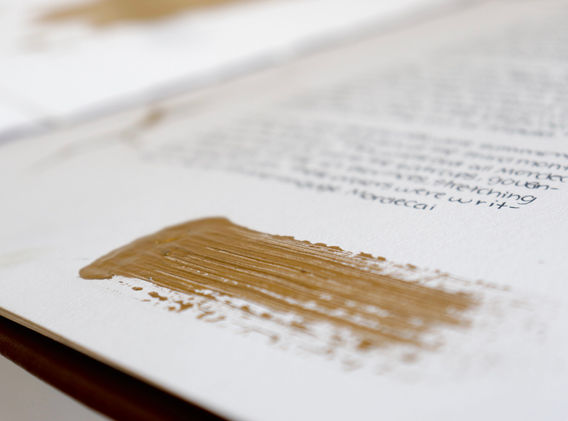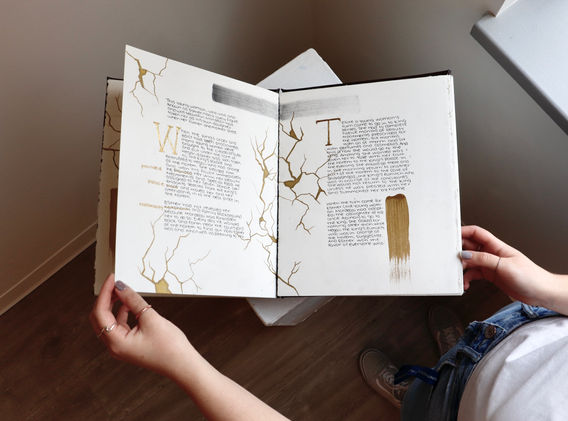Prior to the invention of the printing press, books were handwritten in forms of Illuminated manuscripts. These manuscripts were tediously inscribed in gorgeous calligraphy and decorated with ink and gold leaf over several years. This process required such patience and dedication that it was considered a sacrificial act. The whole process includes preparing the parchment, planning out spacing, hand lettering, illustrating, and finally gold leafing. This onerous process required each person working with it to be very careful of mistakes, for fear of having to make a new parchment from scratch. However, mistakes are inevitable.
The part of this process that I most connected with was how the scribes responded to mistakes. Instead of having to remake an entire page due to one hole or misspelling, the scribe would make corrections directly onto the page. In some of the manuscripts, the scribe would write text around the holes and they would add corrective text into the margins with arrows. As someone who has often been paralyzed by perfectionism, I find this way of embracing mistakes so beautiful.
This reminds me of the Japanese practice Kintsugi where a potter mends broken pottery with gold paint, drawing attention to the brokenness instead of disguising it. I incorporate this concept in my project by highlighting my mistakes in gold. Every embarrassing misspelling is corrected in the margins with gold ink catching the viewer’s eye. Instead of trying to make the broken bowl exactly as it was before it was damaged, the artist creates a new piece decorated with sharp gold edges. Embracing error can result in a piece stronger than without.
For this project, I wanted to emphasize the sacrifice and dedication behind the creation of these ancient manuscripts. Giving up one’s time in order to produce something dedicated to God was my inspiration. Handwriting each word of the book of Esther onto these pages was the most strenuous part that I dreaded. Flipping through the pages, one is able to see my inconsistent and sloppy writing varying in size and spacing which makes it easy to tell when I had been working for several hours and when I just began. Forcing myself to sit down and write amidst all of my other classwork was a huge hurdle that I had to get through. Using my very limited free time to copy the Bible was my way of dedicating this project to God and to all of the scribes who have gone before me.
Brokenness is an important theme in the book of Esther. Esther came from a broken home which we can infer by her living with her cousin Mordecai. We don’t have all the details but we do know that at some point in her life, Esther was broken into pieces. Like the Japanese potters, God saw potential in her brokenness and He used Esther to bring freedom to His Jewish people. Through this work I embrace inevitable mistakes, producing a handcrafted manuscript that foregrounds my human error. In my manuscript, I embrace imperfection as a beautiful and necessary part of the illuminated manuscript process.

Handwritten Pages
I have handwritten the entire Biblical book of Esther onto these pages as a tribute to the ancient scribes who have gone before me. The way they meticulously wrote out each letter in beautiful calligraphy inspired me to embrace my imperfect handwriting in this project. Flipping through the pages, one is able to tell where I was fresh to the project and where I had been working for a while based on the quality of the writing.
Hand Binding
I am human, I am flawed. I chose to hand bind my manuscript to emphasize this. The inconsistent and messy knots tied together are representative of my human nature.


Kintsugi Crack Detailing
The gold crack detailing represents the Japanese practice of mending broken pottery with gold paint. Instead of trying to fix the pottery and eliminate the mistakes, the artists emphasize the mistakes and make the pottery a different piece than what it was before.
Corrections
Just like the Kintsugi artists, I decided to correct my mistakes by drawing attention to them. Whenever I would make a mistake when I was writing out the text, I crossed it out and corrected it in the margins.


Graphite and Gold Brushstrokes
To embellish my manuscript, I decided to use bold brushstrokes of graphite and gold paint. These break up the negative space with beautiful inconsistent strokes. Graphite can be used as a preliminary step before the artist goes in with something more permanent. In this case, it is the permanent step and that contrasts against the permanence of the gold paint brushstrokes.



















